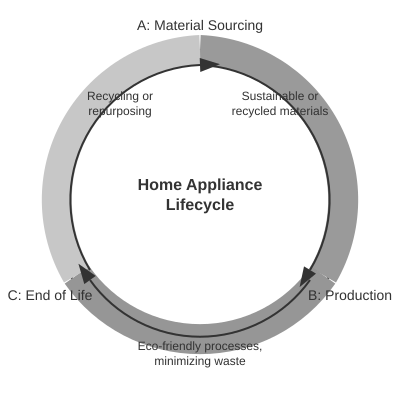Practice 5.5 Product life cycle with authentic IB Design Technology (DT) exam questions for both SL and HL students. This question bank mirrors Paper 1, 2, 3 structure, covering key topics like materials and processes, product design, and sustainability. Get instant solutions, detailed explanations, and build exam confidence with questions in the style of IB examiners.
What kind of obsolescence best fits a product that has been replaced because of changing consumer tastes?
A company is planning to develop a new line of sustainable home appliances. These appliances must be energy-efficient, environmentally friendly, and designed for long-term use.
The design team must consider various aspects such as material selection, energy consumption, and lifecycle impacts. The following questions will explore different aspects of sustainable design in the context of home appliances.
Define sustainable design, outlining its key aspects, and explain its importance in the development of home appliances.
Describe two sustainable materials that could be used in the design of home appliances.
Explain the concept of lifecycle assessment (LCA) and its role in the sustainable design of home appliances.
The diagram below shows the stages of a home appliance lifecycle in sustainable design. Label the parts A, B, and C and explain their significance.

Propose three strategies a company can implement to enhance the sustainability of its home appliance designs.
Innovation and markets refer to the process of developing new products, services, or processes and introducing them to the market.
This involves understanding market needs, creating value, and strategically positioning the innovation to achieve competitive advantage. Key concepts include market pull, technology push, product life cycle, diffusion of innovation, and disruptive innovation.
Explain two stages of the product life cycle.
Define 'disruptive innovation' and provide an example of a disruptive innovation in the technology sector.
Discuss the difference between 'market pull' and 'technology push' in the context of innovation.
Explain the concept of 'diffusion of innovation' and describe the five categories of adopters.
Analyze the impact of innovation on market competition and provide an example of a company that has gained a competitive advantage through innovation.
Drones have become more widespread and can be used for leisure, business or militarypurposes. A drone is operated using a handset, see Figure 1.
Figure 1: A drone and its handset
List two reasons why temporary joining techniques are used when a droneis assembled.
Explain why finite element analysis (FEA) would be used in the development ofthe drone.
Explain two ways that drones can become obsolete.
Explain how the study of human factors can be used to improve the comfort, safety and performance of the handset that controls the drone.
The clapperboard was invented in Melbourne in the 1930s for sound and sight alignment during filming.
Explain why the clapperboard is in the maturity phase of its product cycle.
Outline why the clapperboard can be defined as a classic design.
The four stages of a product life cycle are launch, growth, maturity and decline. Which of the following occurs in the decline stage?
What is it called when a company produces different models of the same product at different prices?
At which stage of the product life cycle might a company consider releasing a new generation of the product?